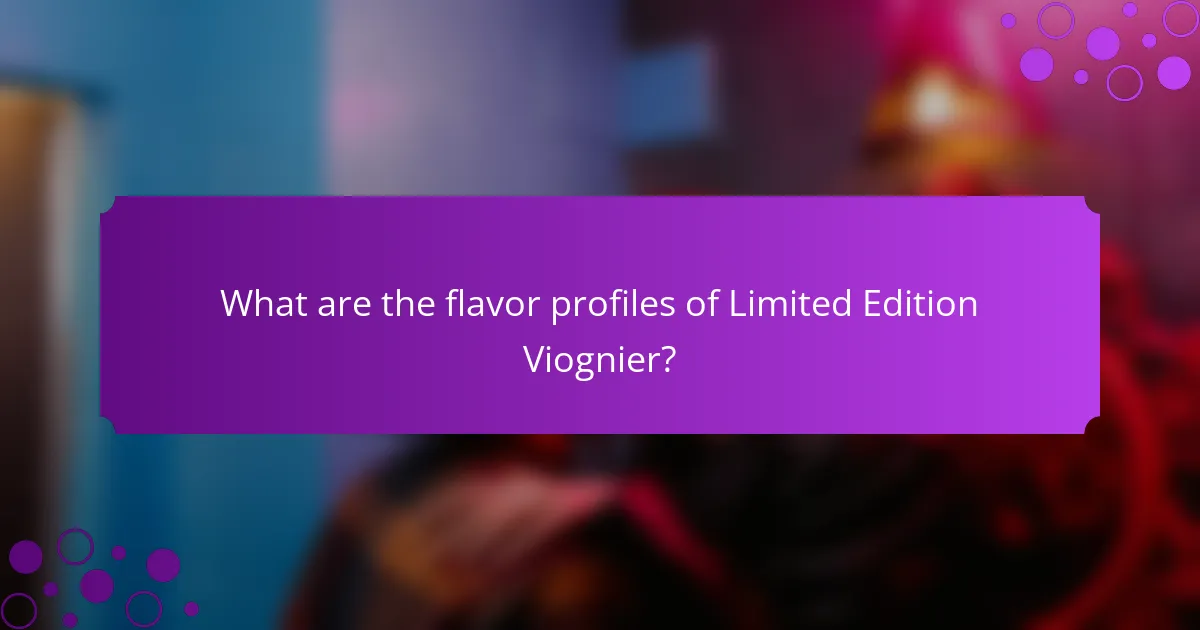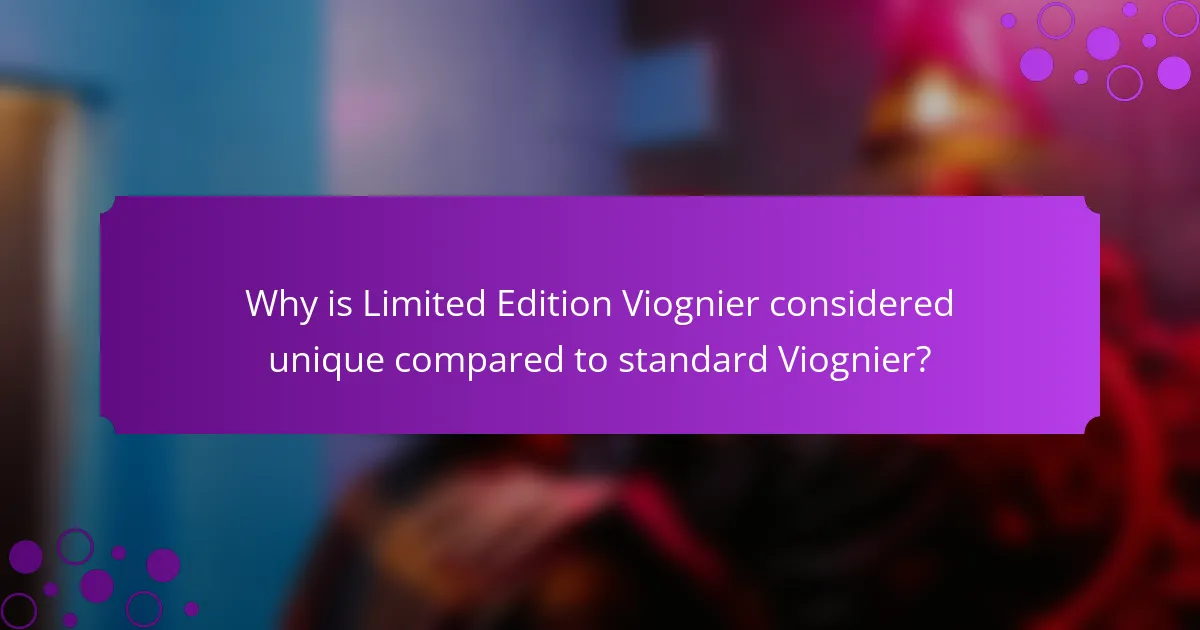
What are the flavor profiles of Limited Edition Viognier?
Limited Edition Viognier typically features floral notes, particularly aromas of jasmine and honeysuckle. It also exhibits stone fruit characteristics, including flavors of peach and apricot. Citrus undertones may be present, adding brightness to the profile. The wine often has a creamy texture, enhancing its richness. Additionally, Limited Edition Viognier may present hints of spice or minerality, depending on the winemaking process. These flavor profiles contribute to its complexity and appeal.
How do floral notes define the character of Limited Edition Viognier?
Floral notes are essential in defining the character of Limited Edition Viognier. They contribute to the wine’s aromatic complexity and overall appeal. Common floral aromas include honeysuckle, jasmine, and orange blossom. These notes create a vibrant and inviting bouquet. The presence of floral elements enhances the perception of freshness in the wine. They also complement the stone fruit characteristics typical of Viognier. This interplay results in a balanced and harmonious flavor profile. Ultimately, floral notes elevate the tasting experience, making Limited Edition Viognier distinctive and memorable.
What specific floral aromas are commonly found in Limited Edition Viognier?
Limited Edition Viognier commonly features floral aromas such as jasmine, honeysuckle, and orange blossom. These aromas contribute to the wine’s aromatic complexity. Jasmine is often noted for its sweet and fragrant profile. Honeysuckle adds a rich, nectar-like quality. Orange blossom provides a fresh and citrusy floral note. Together, these aromas enhance the overall sensory experience of Viognier.
How do these floral notes vary between different vintages of Viognier?
Floral notes in Viognier vary significantly between different vintages. Each vintage can display unique aromatic profiles influenced by climate, soil, and winemaking techniques. For instance, warmer vintages often yield more pronounced floral aromas, such as jasmine and honeysuckle. Conversely, cooler vintages may highlight subtler floral notes, like orange blossom.
The aging process also impacts these floral characteristics. Older vintages may develop more complex aromas, integrating floral notes with honey and spice. Research indicates that the specific terroir and weather conditions during the growing season directly affect the aromatic expression of Viognier. Thus, tasting multiple vintages can reveal a fascinating spectrum of floral nuances.
What stone fruit characteristics are present in Limited Edition Viognier?
Limited Edition Viognier exhibits distinct stone fruit characteristics, primarily featuring flavors of peach and apricot. These fruits contribute to the wine’s aromatic profile. The peach notes provide a juicy, sweet quality. Apricot adds a touch of tartness and complexity. Together, they create a balanced flavor experience. The presence of these stone fruits enhances the overall richness of the wine. Such characteristics are typical for Viognier, aligning with its varietal profile. The stone fruit flavors are often complemented by floral and citrus notes as well.
Which stone fruits are most commonly associated with Limited Edition Viognier?
Limited Edition Viognier is most commonly associated with stone fruits such as peach, apricot, and nectarine. These fruits contribute to the wine’s aromatic profile. Peaches provide a juicy sweetness. Apricots add a hint of tartness. Nectarines enhance the overall fruitiness. The presence of these stone fruits is often noted in tasting notes and wine reviews. Their characteristics complement the floral notes typical of Viognier.
How do these stone fruit flavors influence the overall taste experience?
Stone fruit flavors significantly enhance the overall taste experience by adding complexity and depth. These flavors, such as peach, apricot, and plum, contribute sweetness and acidity. This balance creates a harmonious profile that complements floral notes in Viognier. The presence of stone fruit can also evoke freshness, making the wine feel more vibrant. Additionally, the juiciness associated with these fruits can enhance mouthfeel. Research indicates that fruit flavors can influence consumer perception positively. A study published in the Journal of Wine Research found that stone fruit notes are often linked to higher quality ratings in white wines. Thus, the integration of stone fruit flavors in Viognier elevates its sensory appeal.
What are the ideal serving conditions for Limited Edition Viognier?
The ideal serving conditions for Limited Edition Viognier include a serving temperature of 45 to 50 degrees Fahrenheit. This temperature range enhances the wine’s floral and stone fruit characteristics. The wine should be served in a tulip-shaped glass to concentrate its aromas. Limited Edition Viognier pairs well with light dishes like seafood and salads. It is best enjoyed within a year or two of its release. These conditions ensure the wine’s flavors are fully expressed.
What temperature is best for serving Limited Edition Viognier?
The best temperature for serving Limited Edition Viognier is between 45°F and 50°F (7°C to 10°C). Serving this wine at this temperature enhances its floral notes and stone fruit characteristics. Chilling Viognier within this range preserves its aromatic profile. This temperature allows the wine’s complexity to shine without overwhelming the palate. Many wine experts recommend this range for optimal enjoyment.
How does glassware choice affect the enjoyment of Limited Edition Viognier?
The choice of glassware significantly affects the enjoyment of Limited Edition Viognier. Different glass shapes influence aroma concentration and flavor perception. A wider bowl allows for better aeration, enhancing the wine’s floral notes and stone fruit characteristics. In contrast, a narrower glass may restrict these aromas, diminishing the overall experience. Studies indicate that the right glass can amplify specific flavor components, making the wine more enjoyable. For example, a tulip-shaped glass helps direct aromas to the nose, providing a fuller tasting experience. Thus, selecting appropriate glassware is crucial for maximizing the enjoyment of Limited Edition Viognier.

Why is Limited Edition Viognier considered unique compared to standard Viognier?
Limited Edition Viognier is considered unique compared to standard Viognier due to its exceptional quality and distinct flavor profile. Limited editions often involve grapes sourced from select vineyards, which enhances their characteristics. These wines typically undergo specific winemaking techniques, such as extended aging or unique fermentation processes. This results in pronounced floral notes and intense stone fruit flavors. Additionally, limited editions may feature lower production volumes, making them rarer and more sought after. The exclusivity contributes to their perceived value among wine enthusiasts.
What factors contribute to the limited edition status of certain Viognier wines?
Limited edition status of certain Viognier wines is influenced by several key factors. These wines often come from specific, prestigious vineyards known for unique terroir. Limited production quantities enhance exclusivity and desirability. Vintage variations also play a role, with exceptional years producing standout wines. Winemaking techniques, such as small-batch fermentation, contribute to unique flavor profiles. Additionally, market demand and collector interest can elevate certain releases to limited edition status. These factors collectively create a perception of rarity and quality, making selected Viognier wines highly sought after.
How does winemaking technique influence the flavor profiles of Limited Edition Viognier?
Winemaking technique significantly influences the flavor profiles of Limited Edition Viognier. Techniques such as fermentation temperature, aging process, and use of oak barrels shape the wine’s characteristics. Higher fermentation temperatures enhance floral notes and fruitiness. Cooler temperatures preserve acidity and freshness in the wine. Aging in oak barrels adds complexity and introduces vanilla or spice flavors. Additionally, skin contact during fermentation can intensify the wine’s aromatic profile. Different winemakers may apply unique techniques, resulting in distinct flavor variations. For instance, some may choose malolactic fermentation to soften acidity, altering the overall taste experience. These methods collectively contribute to the unique expression of Limited Edition Viognier.
What role does terroir play in the uniqueness of Limited Edition Viognier?
Terroir significantly influences the uniqueness of Limited Edition Viognier. It encompasses the specific environmental conditions where the grapes are grown. These conditions include soil composition, climate, and topography. Each of these factors contributes to the flavor profile of the wine. For example, well-drained soils can enhance the mineral qualities in the wine. Additionally, the climate affects grape ripening and acidity levels. Cooler regions may yield more floral notes, while warmer areas can produce richer stone fruit flavors. The interaction of these elements creates distinctive characteristics in each Limited Edition Viognier. Ultimately, terroir is essential in defining the wine’s identity and complexity.
How can consumers identify high-quality Limited Edition Viognier?
Consumers can identify high-quality Limited Edition Viognier by examining its aroma, taste, and origin. A distinct floral bouquet, often resembling honeysuckle or jasmine, is a key indicator. High-quality Viognier typically exhibits stone fruit characteristics, such as peach or apricot flavors. The mouthfeel should be smooth and creamy, indicating good aging potential.
Additionally, consumers should look for wines sourced from reputable vineyards known for Viognier production. Regions like Condrieu in France are renowned for high-quality Viognier. The label should indicate limited edition status, often signifying careful selection and production.
Finally, checking for reviews from wine experts or ratings from reputable sources can further validate quality. High-quality Viognier often receives accolades and high scores from wine critics.
What labels or certifications should consumers look for?
Consumers should look for labels such as “Certified Organic” and “Sustainable Winegrowing.” These certifications indicate adherence to environmentally friendly practices. Additionally, “Vegan” labels are important for those avoiding animal products in winemaking. Certifications from recognized organizations, like the California Sustainable Winegrowing Alliance, provide assurance of quality. The “Low Sulfites” label appeals to consumers sensitive to sulfites. The “Biodynamic” certification signifies a holistic approach to farming, enhancing flavor profiles. These labels help consumers make informed choices about the quality and production methods of Viognier wines.
How can tasting notes help in selecting Limited Edition Viognier?
Tasting notes can significantly aid in selecting Limited Edition Viognier by highlighting its unique flavor characteristics. These notes often describe floral aromas, such as jasmine or honeysuckle, which are typical of Viognier. They also detail stone fruit flavors like peach, apricot, and nectarine. Understanding these profiles helps consumers identify wines that align with their preferences. Tasting notes may also indicate the wine’s acidity and body, which are crucial for food pairing. Furthermore, they can provide insights into the wine’s aging potential and overall complexity. This information allows for informed decisions when choosing a Limited Edition Viognier that meets specific taste expectations.

What food pairings enhance the experience of Limited Edition Viognier?
Limited Edition Viognier pairs well with seafood, particularly scallops and shrimp. These dishes complement the wine’s floral notes and stone fruit characteristics. Chicken dishes, especially those with citrus or herb marinades, also enhance the experience. The acidity in the food balances the wine’s richness. Spicy Asian cuisine, such as Thai or Indian dishes, works well due to the wine’s fruity profile. Soft cheeses, like Brie or Camembert, provide a creamy texture that matches Viognier’s body. These pairings create a harmonious balance between food and wine, enhancing overall enjoyment.
What types of cuisine complement the flavor profiles of Limited Edition Viognier?
Limited Edition Viognier pairs well with Asian cuisine, particularly dishes featuring seafood and aromatic spices. The floral notes in Viognier enhance the flavors of dishes like sushi and Thai curry. Additionally, Mediterranean cuisine, especially grilled vegetables and herb-infused dishes, complements its stone fruit characteristics. The wine’s acidity balances rich flavors found in creamy sauces, making it suitable for pasta dishes as well. Overall, Viognier’s versatility allows it to enhance a variety of culinary experiences.
How do floral notes interact with different dishes?
Floral notes enhance various dishes by adding complexity and brightness. They complement light proteins like fish and chicken, enhancing their flavors. Floral notes also pair well with salads, particularly those featuring citrus or fruits. They can elevate dishes with herbs, such as basil or mint, creating a refreshing balance. In desserts, floral notes provide an aromatic contrast to sweet elements. This interaction often results in a more nuanced tasting experience. Research shows that floral aromas can stimulate appetite and enhance overall enjoyment of food. Thus, incorporating floral notes can significantly enhance culinary experiences.
What stone fruit characteristics pair well with specific foods?
Stone fruit characteristics such as sweetness, acidity, and juiciness pair well with specific foods. Sweetness complements savory dishes like grilled meats and cheese. Acidity enhances the flavors of rich foods, balancing cream-based sauces and fatty fish. Juiciness adds freshness to salads and desserts, making them more vibrant. For example, peaches pair well with prosciutto due to their sweetness and acidity. Plums complement duck dishes, as their tartness cuts through the richness. Cherries work well in both sweet and savory applications, enhancing pork and chocolate desserts alike. These pairings are rooted in the flavor profiles of the fruits and the complementary nature of the foods they accompany.
What tips can enhance the enjoyment of Limited Edition Viognier?
Serve Limited Edition Viognier chilled between 45-50°F to highlight its floral and stone fruit notes. Pair it with light dishes like seafood or salads for a complementary taste experience. Use appropriate glassware, such as a white wine glass, to enhance aroma and flavor. Allow the wine to breathe for about 15-30 minutes before drinking. This aeration can soften the flavors and enhance complexity. Consider tasting it alongside a variety of cheeses to discover different flavor pairings. Finally, take time to savor each sip, focusing on the wine’s unique characteristics.
How should one prepare a tasting experience for Limited Edition Viognier?
To prepare a tasting experience for Limited Edition Viognier, start by selecting the right glassware. Use a tulip-shaped glass to enhance the wine’s aromatic qualities. Next, chill the Viognier to a temperature between 50-55°F to preserve its floral notes. Pour a small amount into each glass to allow for swirling and aeration.
Pair the wine with complementary foods. Ideal pairings include seafood, poultry, or dishes featuring stone fruits. Provide tasting notes for participants to refer to during the experience. This will help them identify the wine’s unique characteristics.
Encourage participants to observe the color, swirl the glass, and inhale the aromas. This engages their senses and enhances the tasting experience. Finally, facilitate a discussion about the flavors and impressions of the wine, focusing on its floral and fruity attributes.
What common mistakes should be avoided when serving Limited Edition Viognier?
Common mistakes to avoid when serving Limited Edition Viognier include serving at the wrong temperature. Ideal serving temperature for Viognier is between 50°F and 55°F. Serving it too cold can mute its floral and stone fruit aromas. Conversely, serving it too warm can enhance alcohol perception and diminish the wine’s complexity. Another mistake is using inappropriate glassware. A tulip-shaped glass enhances the aromatic profile. Lastly, neglecting food pairings can lead to an unbalanced experience. Viognier pairs well with rich dishes like seafood and creamy sauces, enhancing both the wine and the meal.
Limited Edition Viognier is characterized by its distinct floral notes, including jasmine and honeysuckle, as well as stone fruit flavors such as peach and apricot. The article explores how these flavor profiles contribute to the wine’s complexity, with variations across different vintages influenced by terroir and winemaking techniques. Ideal serving conditions, including temperature and glassware selection, are discussed to enhance the tasting experience, alongside recommended food pairings that complement the wine’s unique characteristics. Additionally, the article highlights factors that establish the uniqueness and quality of Limited Edition Viognier compared to standard offerings.